Trees with multiple stems are rapidly becoming popular due to their ability to provide a more organic appearance compared to trees with a single, clear stem.
Their branches which tend to shoot out near the base of the tree with a very short trunk section make them suitable for filling in empty spaces of a yard or garden with greenery.
Below we go through the most popular species you can plant in your garden.
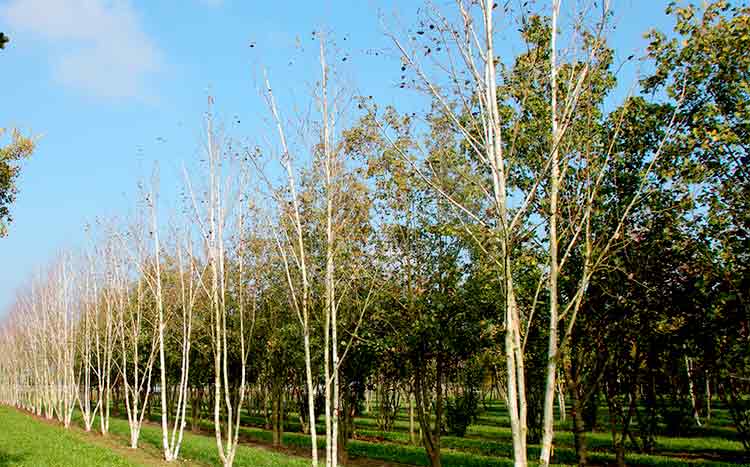
What we cover
ToggleWhat are multi stem-trees?
Multi-stem trees are basically those that have more than one stem growing close to the ground from a common root. These multiple stems are usually a result of the application of specific pruning techniques at an early age.
The branches of multi-stem trees which usually begin to appear on the lower part of their trunks also set them apart. It is however important to note that these branches are normally higher up the bole than those of shrubs.
List of popular multi-stem trees
| Name | Botanical name | Max height | Deciduous? |
|---|---|---|---|
| Japanese Maple | Acer palmatum | 33 ft. | Yes |
| Himalayan Birch | Betula utilis var | 50 ft. | Yes |
| Juneberry | Amelanchier lamarckii | 25 ft. | Yes |
| Tibetan Cherry | Prunus serrula var | 30 ft. | Yes |
| Japanese Crabapple | Malus floribunda | 25 ft. | Yes |
| Golden-rain tree | Koelreuteria paniculata | 40 ft. | Yes |
| Chinese Dogwood | Cornus kousa | 25 ft. | Yes |
| American sweetgum | Liquidambar styraciflua | 75 ft. | Yes |
Japanese Maple
Often known as the Japanese Maple, the Acer palmatum often produces green vegetation during summer and springtime. This foliage however turns into a deep scarlet shade at the beginning of autumn thus providing a rather classical and serene look.
This majestic autumn drama coupled with a beautiful open habit makes it suitable for smaller gardens. It is fairly fast-growing and can spring up to a height of 33 feet in environments without direct sunlight.
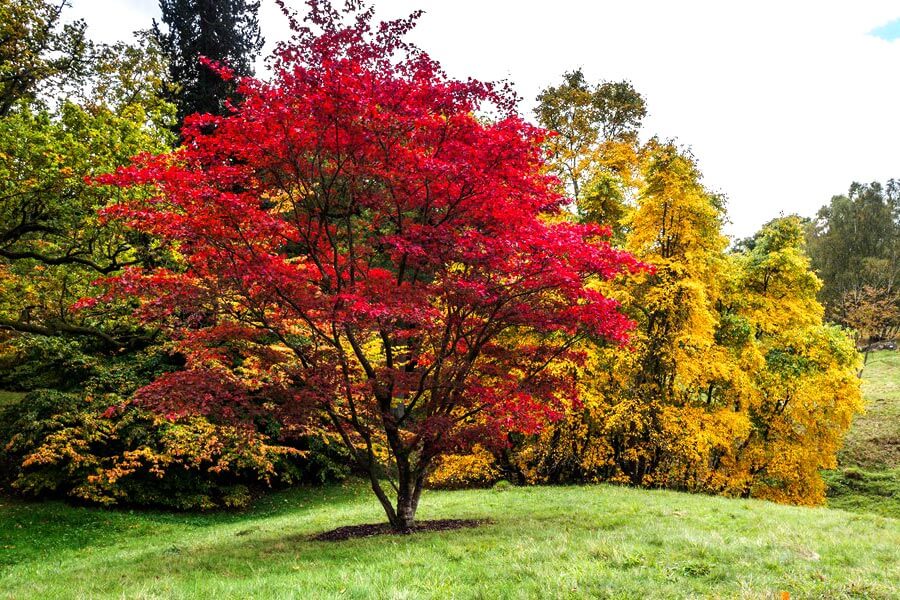
Himalayan Birch
Otherwise known as the Himalayan birch, the Betula utilis var normally grows at an annual rate of 1.5 feet in moist well-drained soils. This growth is characterized by the peeling of its rather shiny and white bark.
Its leaves also shed off after changing from a dark shade of green to a golden hue during autumn. It is, therefore, suitable for garden environments where the full extent of its color transitions can be displayed.
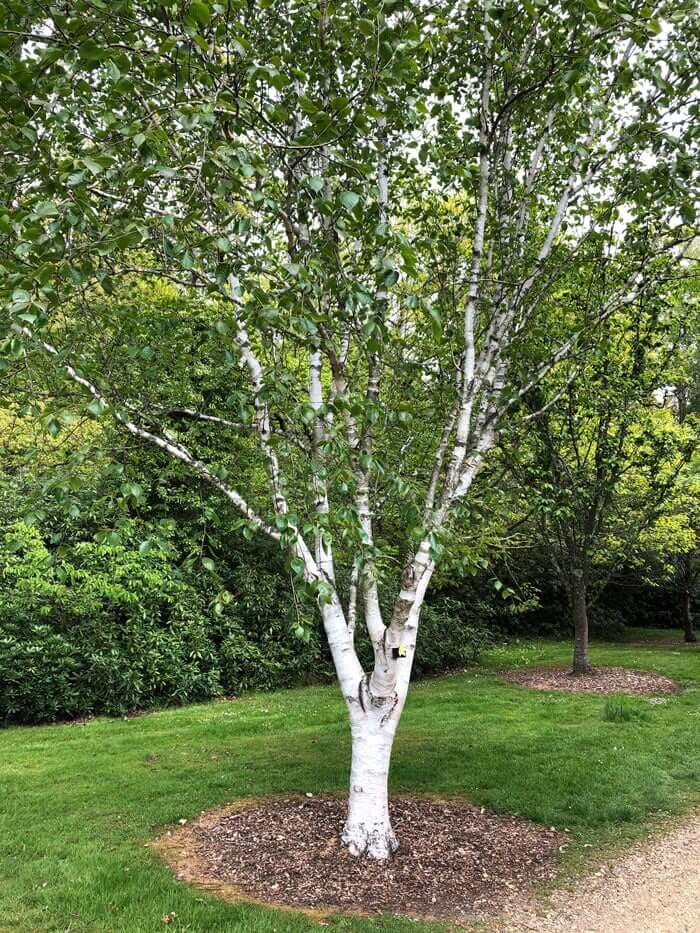
Juneberry
The Amelanchier lamarckii is also commonly known as the Juneberry. It usually grows at an average rate of 1.25 feet yearly.
Its color change normally begins with its red leaves which turn into a rather soft shade of green during the summer before progressing into a combination of red, orange, and yellow shades in autumn.
It also has 1-inch wide white flowers which transform into beautiful, edible, dark purple berries after the spring.
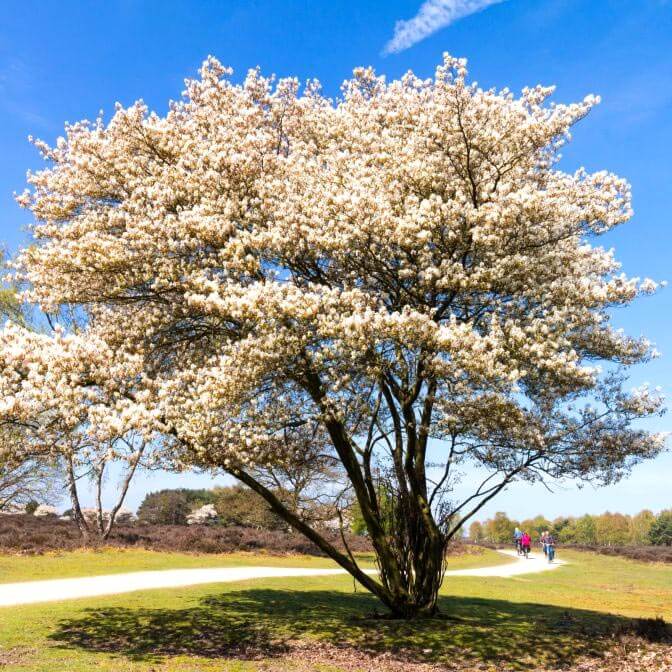
Tibetan Cherry
The Prunus serrula var is often referred to as the Tibetan Cherry. Its annual growth rate is normally about 1 foot. Its rather unique copper-brown bark which is usually punctuated with white circular peelings makes it suitable for open gardens where its magnificence can be continually admired.
It is also known to bear white clusters of bowl-shaped flowers in springtime. These flowers usually grow into tiny summer cherries. It also has mid-green, willow-like leaves which often fade into a yellow shade before falling off at the end of autumn.
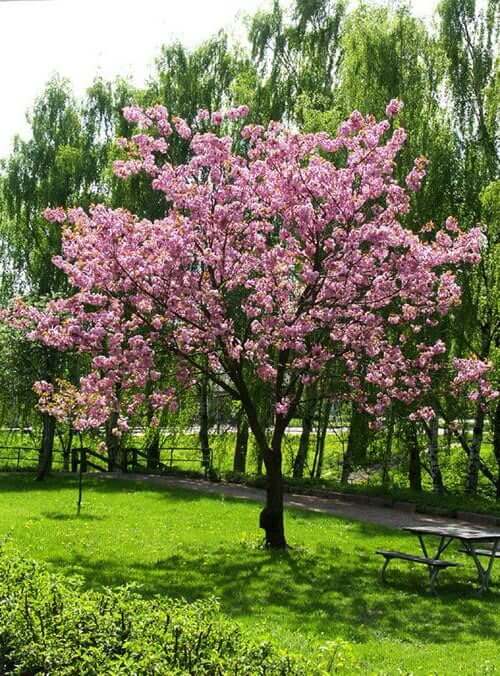
Japanese Crabapple
The Japanese Crabapple usually grows at a mean rate of 24 inches yearly. Its light red buds which open up to 1-inch wide white flowers in summer are undoubtedly the center of its beauty.
These flowers eventually mature into small red and yellowish-green crab apples which not only beautifully contrast with its light brown autumn leaves but also provide food in the winter for the wild animals.
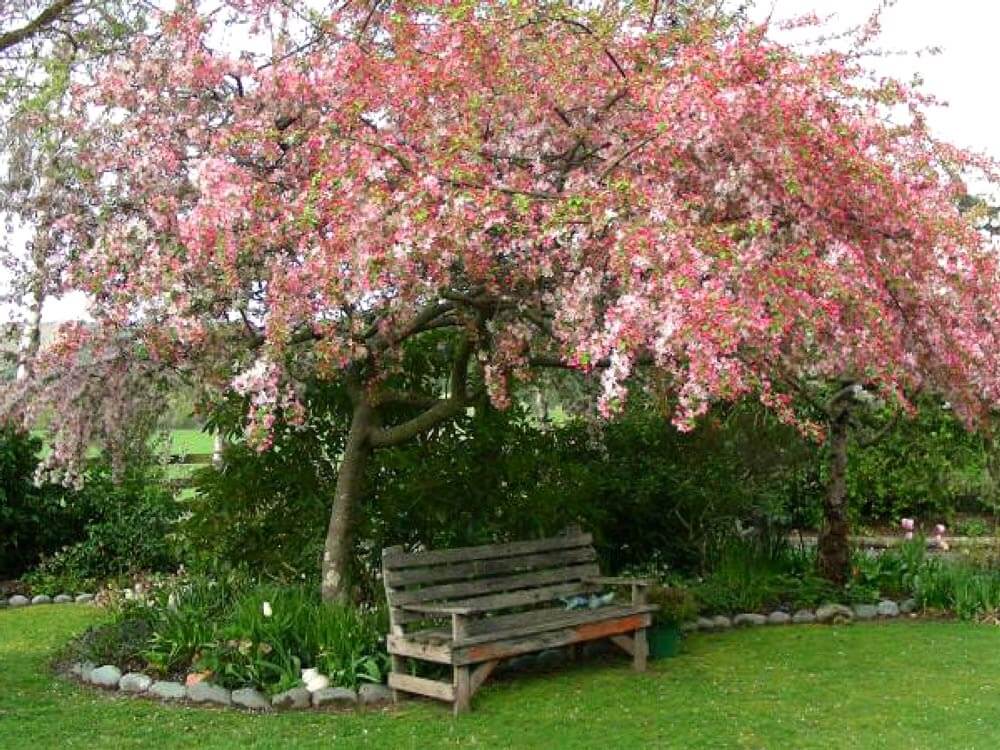
Golden Rain Tree
The beautiful compound leaves of the Golden rain tree provide a charming red-green-yellow color transition seasonally. Its tiny yellow flowers meanwhile mature into small pink fruits which add personality and splendor to its conspicuously open habit.
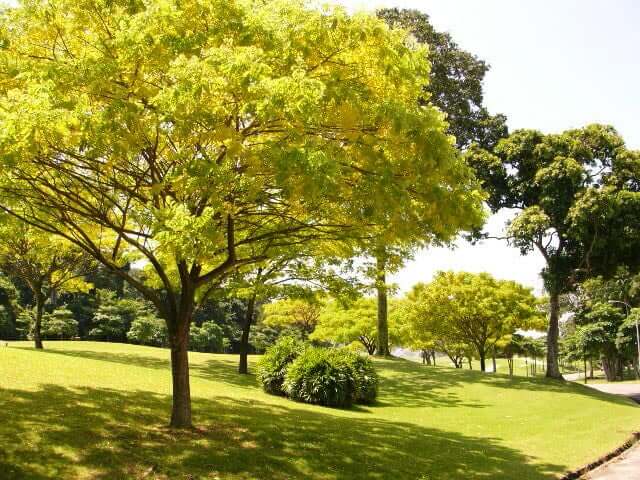
Chinese Dogwood
Growing at a mean rate of 1.5 feet annually, the Chinese Dogwood is also known to be suitable for both under-planting and mixed hedges. Its white flower clusters usually grow into pink edible berries while its green foliage turns reddish-orange.
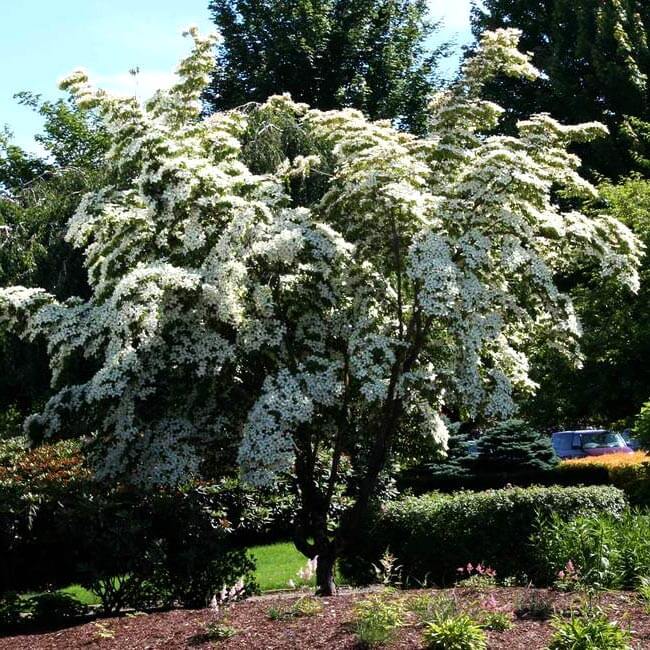
American Sweet Gum
The magnificent autumn display of the Sweet Gum makes it one of the most beautiful deciduous trees to observe even though its flowers and fruits lack botanical significance.
This is because it has large, lobed green leaves which transform into enchanting shades of purple, orange, and red during autumn. It is known to grow best in mildly acidic soils.
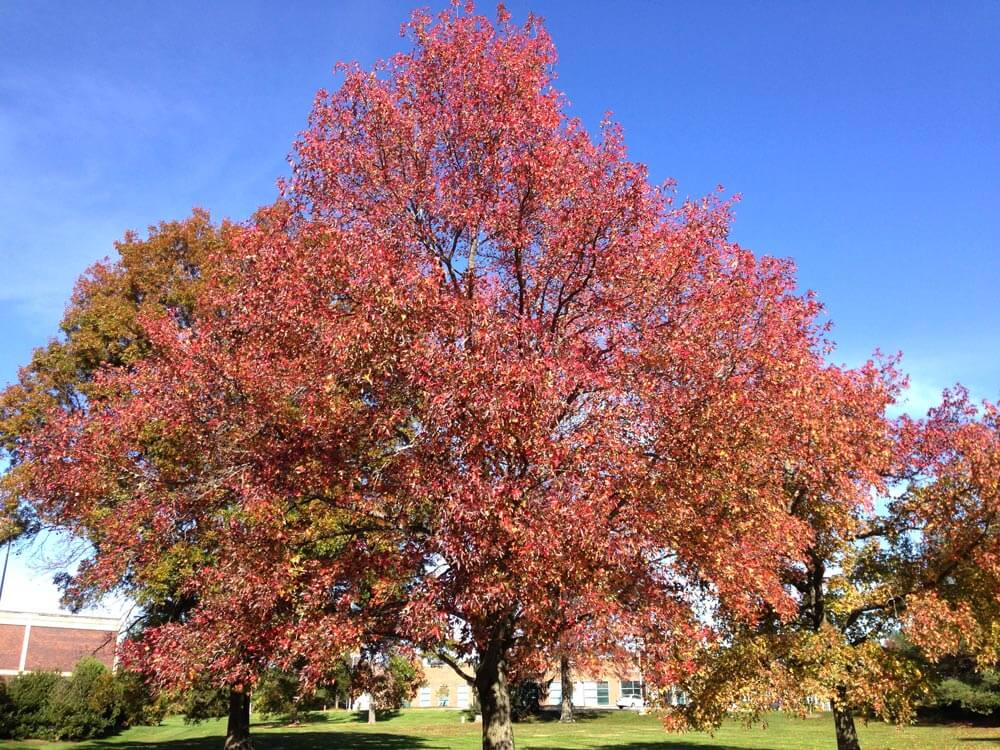
Clear stem vs branched vs multi-stem tree?
Clear-stem trees usually have a distance of at least 6 feet between the ground and their lowest branches. They also possess a rather rounded top which is made up of a collection of branches and leaves that display a crown-like appearance.
They are normally planted along urban streets, avenues, and pathways in order to improve aesthetic appearance while also providing some shade for pedestrians to walk under.
Branched or feathered trees are simply those that often possess large boughs and small twigs as part of their structure. Their low boughs coupled with their wide base and naturally dominant trunks make them aesthetically suitable for house decorations.
Multi-stem trees are generally made up of more than one dominant stem. These stems are known to spring forth at ground level despite the fact that they are connected to a similar root system.
They often come into existence as a result of applying specialized pruning methods during their early development. Multi-stem trees are thus considered suitable for places whose natural and rustic appearance needs to be maintained.
The advantages of multi-stem trees
The open structure that multi-stem trees1 possess at their base makes them suitable for spaces whose open personality needs to be maintained. This is unlike clear-stemmed trees whose appearance and growth pattern are extremely unnatural.
Multi-stem trees also have similarities as far as the thickness and circumference of their stems are concerned. This often provides them with a greater mass in terms of vegetation when compared to standard trees.
They are therefore able to keep the environment greener and more aesthetically pleasing while also providing more shade than standard trees. This in turn gives them a better environmental rating than both clear-stem and branched trees.

Is a multi-stem a tree or shrub?
A multi-stem tree usually embodies both tree and shrub characteristics. It’s rather short height combined with numerous stems makes it quite similar to shrubs. They however also possess a large mass of foliage just like trees.
Uses of multi-stem tree in a garden
Viewing
Multi-stem trees possess a structural openness that allows them to be viewed from multiple angles. This, in turn, facilitates the effective viewing and appreciation of other plants, particularly in small and medium–sized mixed gardens.
When grown in groups, this type of structure also enables multi-stem trees to give the garden a structural backbone that works well with the background made up of other plants.
Adventure
The structure of multi-stem trees also allows them to act as directional barricades. This is important because it creates a variety of paths through which the rest of the garden can be explored.
This is especially vital in large gardens which have long panoramic views which may need to be broken up using punctuating structures that are neither too large to spoil the outlook nor too small to be ignored.
Shade
Multi-stem trees can also provide speckled shade over an area thereby making it suitable for activities such as picnics and sitting. This type of shade allows sunlight to reach the said area in an indirect manner.
This means that the recipient will neither feel too hot as a result of direct sunlight nor too cold as a function of large canopy trees which completely shut out the sun.
Nature
The function of gardens in creating and maintaining an open, natural, and informal setting provides the perfect place as far as showcasing multi-stem trees is concerned.
This is because they have an open and organic appearance that precedes the artificial and unnatural structure of other types of trees such as clear-stemmed trees.
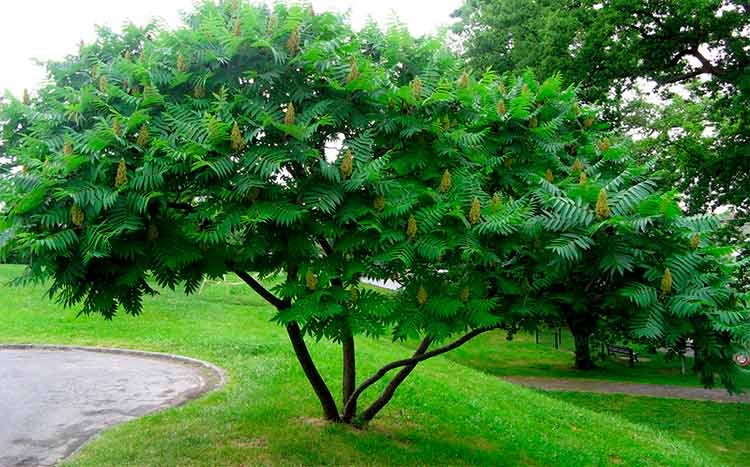
Diversity and Continuity
Large gardens with standard-type trees are particularly suitable for multi-stem trees. This is because they are able to break the monotony of such tree forms through their open structure.
They also have the ability to ensure continuity by inhibiting the growth of competing weeds which can choke up the growth of other plants if not curtailed in the long-term.
What are the potential risks with multi-stem trees?
Since multi-stem trees usually originate from the same root system, they are sometimes prone to having weak stem meeting points. This may eventually make the stems grow exceedingly apart which often results in the falling over of either one or all stems.
This is especially common among multi-stem trees whose stem junctions are “V” shaped above the ground as opposed to being “U” shaped. For the former, professional cabling and bracing may come in handy as far as reinforcing weak stem unions is concerned.
You can get three estimates from local tree service professionals in a matter of two minutes. Kindly follow the steps below to enjoy this great service:
- Scroll to the top of the page and enter your zip code
- Answer questions about your tree service job
- Your tree service details are forwarded to three local experts who will send you a price estimate for your job with some friendly advice.
FAQ's
Yes, they do. The general size of a multi-stem tree is quite diminished when compared to its standard equivalent. This is because multi-stem trees are usually subjected to early-age pruning which shapes and slows their growth pattern.
The altering of their growth pattern usually means that they are required to channel energy to multiple growth points which is certainly not the case for standard trees. It is this multi-directional channeling of energy that limits the rate of their growth.
Multi-stemmed trees are generally a function of early-age pruning. Early age in this case is usually about 2 years. Once a tree has lived for this duration of time, an 8 cm linear cut can be applied on its main stem above the earth.
Any rough edges should then be trimmed in order to make sure that the shoot in question is not susceptible to infection. Once this is done, the stem will be stimulated to bud afresh thereby producing new shoots which will eventually grow into multiple stems.
- Van den Berk Nurseries, (2019) Multi-stem trees: a list of species and characteristics. <https://www.vdberk.com/inspiration/multi-stem-trees/> Accessed: 17-02-2024




